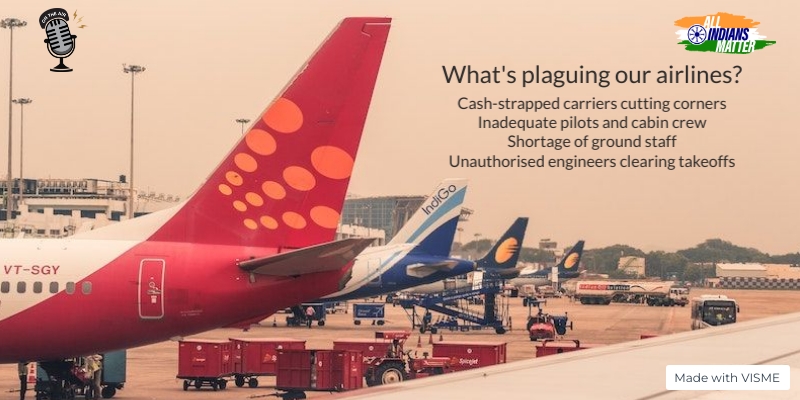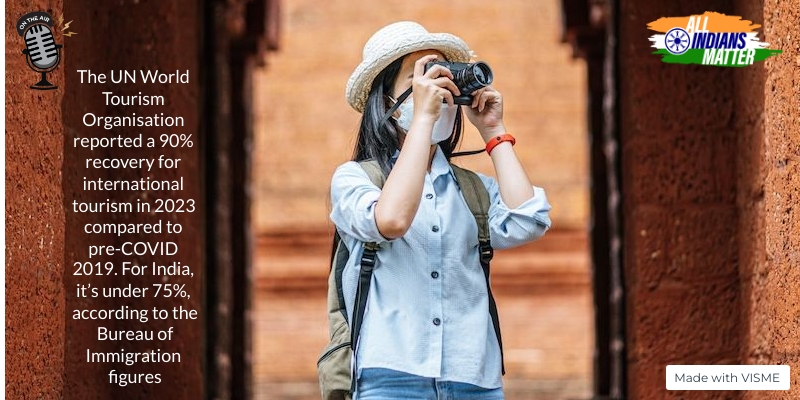Ashraf Engineer
July 23, 2022
EPISODE TRANSCRIPT
Hello and welcome to All Indians Matter. I am Ashraf Engineer.
There’s been a series of malfunctions and close shaves involving passenger flights over the past few days, making fliers nervous and raising serious concerns about air safety in India. These malfunctions involved airlines like SpiceJet, IndiGo and Vistara, and ranged from smoke in the cabin to engine shutdowns and technical problems. Some had to resort to emergency landings. No wonder a survey conducted on July 6 and 7, days after the malfunctions, by Moneycontrol and LocalCircles, said about three out of every four Indians travelling on domestic flights were worried about their safety. Only 16% of the 21,000 fliers surveyed said they were not concerned at all about safety; 42% said they were concerned while flying on a domestic airline in general and 35% said they were only concerned if travelling on a select few airlines. The suspicion among many respondents was that airlines were cutting corners due to a financial crunch following two years of the COVID-19 pandemic and the soaring cost of fuel. So, why are such incidents happening and is it safe to fly in India?
SIGNATURE TUNE
As I said, the survey was published just after the Directorate General of Civil Aviation, or DGCA, served a show-cause notice on SpiceJet after eight incidents involving its planes were registered in 20 days. In fact, the DGCA is being closely watched with about 18% of respondents accusing it of oversight.
The survey apart, there is a general sense that airlines are compromising passenger safety.
This is not the first time airlines have been under the safety scanner. There were concerns even before the pandemic. This is worrying when you put the sector in context – India is the world’s third-largest aviation market and passenger traffic is expected to grow 6.2% per annum by 2040. However, with growing competition and cost pressures, passenger safety seems to be the casualty.
One of the problems is a pilot shortage. In February, Minister Of State For Civil Aviation VK Singh told Parliament that India needs 1,000 fresh commercial pilots every year against the current supply of 200 to 300. We have just over 9,002 pilots in all at the moment.
The Ministry of Civil Aviation responded to the shortage by introducing Online-On Demand Examination for Aircraft Maintenance Engineers and Flying Crew with effect from November 2021. There are other measures that liberalise flight training operations but experts say they are debatable because, while they would go some way in easing the shortage, the quality of pilots would remain an issue. In fact, many pilots have been found to be improperly trained to operate flights and barred by the DGCA.
Let’s now look at the shortage of ground staff, a critical component of any flight operation. No one was more severely affected by the lockdowns than ground staff. According to government data, between April 2020 and December 2021, of the 1.9 lakh employees across airlines, airports, ground handling and air cargo, 19,200 employees – or 10% of the workforce – were laid off. Ground staff formed the bulk of these numbers. Now, according to a TeamLease report, the aviation industry has a deficit of 15,800 ground staff and 1,350 cabin crew.
This has been compounded by salary cuts. The recent delays of IndiGo flights, for instance, were because cabin staff took leave in protest against pay cuts. Many called in sick to interview for Air India jobs.
Now here’s something even more serious. Between January 2021 and March 2022, 84 workers at 42 airports were found drunk on duty. About 64% failed the mandatory breath analyser test. Between January 1 and April 30 of this year, the DGCA suspended nine pilots and 32 crew members of various airlines after they too failed the pre-flight breath analyser test.
The DGCA is now in crackdown mode. It conducted a series of spot checks, which revealed that airlines are improperly identifying causes of defects and not placing qualified engineers at all airports.
It also pointed to the increasing trend of minimum equipment list, or MEL, flights. The MEL allows the plane to be operated safely even if something is sub-optimal, but only under certain circumstances, before it has to undergo repairs. For example, if a landing light isn’t working, the plane might be allowed to fly during daytime.
As far as safety inspections are concerned, before every takeoff, a licenced maintenance engineer inspects the aircraft and green lights it if everything is fine. There are various categories of such engineer licences – Category A is given to those permitted to maintain the aircraft under certain limits; Category B licences are more specialised and deal with intricate components such as engines and wings.
According to the DGCA, airlines have not been posting the relevant qualified engineers at all stations with Category A licence holders greenlighting takeoffs at smaller airports. This is a major safety gap. In essence, the engineer checking your flight may not be fully authorised or qualified to do so. Whether this is the reason for the multiple incidents ranging from engine snags to burning smells in cabins to birds entering the cockpit, only a detailed investigation will tell.
As you can see, there are a million problems plaguing the aviation sector. But how did we get here? Why was the situation allowed to deteriorate to this extent? The airlines must be made to answer but what was the DGCA doing? After all, the DGCA is the aviation watchdog and the responsibility to ensure that airlines adhere to safety norms lies with it. There is something seriously wrong with our aviation processes, and checks and balances. How else do you account for the high number of close shaves in recent times? Thank God there have been no crashes or loss of life. But the DGCA and Ministry of Civil Aviation can’t wait till that happens to tighten the screws. After all, it’s your safety that’s on the line.
What do you think about this latest crisis to befall Indian aviation? Do you feel safe flying? I’d love to know. Write to me at editor@www.allindiansmatter.in.
Thank you all for listening. Please visit allindiansmatter.in for more columns and audio podcasts. You can follow me on Twitter at @AshrafEngineer and @AllIndiansCount. Search for the All Indians Matter page on Facebook. On Instagram, the handle is @AllIndiansMatter. Email me at editor@www.allindiansmatter.in. Catch you again soon.






